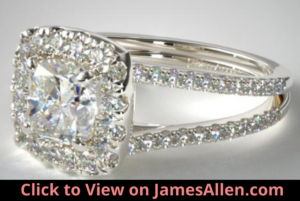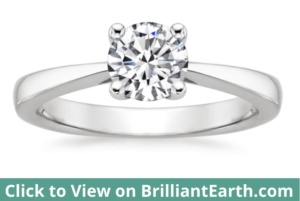
Choosing the perfect ring isn’t only about the diamond on top.
Even though the diamond gets the most attention — and commands the highest price — it’s important to consider each aspect of the piece and how it complements the overall design.
One part of a ring that offers many options to choose from is the ring shank.
Here are 15 types of rings shanks and details on each.
1. Straight Shank
The straight shank is the most basic type available. It features a band with the same width all the way around.
You won’t get any tapering or splitting with a straight shank.
Its sole purpose is to hold the center stone or to be used as a wedding band, and in most cases, the edges are flat. It’s a fitting option if you’ve chosen a large diamond and don’t want the ring distracting from its prominence.
There are instances where the edges are curved to give it a more comfortable fit, but the typical design is symmetrical.
Like most other types, it’s available in a variety of metals such as white, yellow, and rose gold and platinum.
It’s a clean aesthetic that offers a simple but elegant design.
2. Split Shank
Split shanks are a popular choice because it’s affordable but provides a stylish, custom look. It’s a single shank that splits into two once it approaches the center stone.
They’re sometimes confused as two different bands, but upon closer inspection, you’ll see it’s actually a single band that breaks in two.
The example above is a solitaire design, but it’s common to see pave placed along each split, as the top and bottom reach the diamond.
It provides the piece with additional brilliance without the price increase of a heavier center diamond.
3. Open Split Shank
If you’re a fan of the split shank design but want something more dramatic, an open split shank may be the best style for you.
Open split shanks are similar to split shanks but provide a larger opening for more aesthetically-appealing looks.
Instead of a large opening in the middle and a more narrow gap on each end of the ring, it starts narrow but splits wider as it approaches the diamond.
They’re usually paired with rings featuring a larger stone to offset the wider gap between the shanks.
4. Crossover Shank
Those looking for a more complex, elegant design will find a crossover shank takes your ring to the next level.
The crossover shank is identifiable because it’s similar to the split shank, but the two bands cross over each other near the center stone.
These are usually accented by diamonds or other stones to bring out the unique design.
You’ll commonly see the crossover shank leading up to a halo style, where there’s one gem in the center, surrounded by small gems.
One way to create a cohesive look with a crossover shank is to use accents along the shank, leading to complementing diamonds that serve as the halo.
The piece will sparkle from every angle. This is an effective way to enhance the appearance of a ring with a small center diamond. The gems along the shank and ones that form the halo will increase the total carat weight of the ring.
5. Bypass Shank
The bypass shank is a band that doesn’t connect at the center stone.
Instead, it holds the stone and creates a wrapped look. The ends of the shank are offset and hold the center stone and its top and bottom.
If you purchase a bypass shank, specify which hand you plan to wear it on. That’s because they’re made for either the right or left hand and aren’t interchangeable.
In the design above, notice how there are channel set diamonds on the shank. The way the diamonds weave up and down toward the diamond is a unique aesthetic that isn’t matched by many other styles.
6. Tapered Shank
A tapered shank is a basic design with a slight twist. Its identifying quality is instead of having the same width across the entire band, the shank tapers off where it meets the center stone.
You’ll have a normal width on most of the shank but a thinner one closer to the center stone.
This helps to accent the center stone and make it appear bigger than it is. So if you’ve chosen a diamond less than one carat, a tapered shank might be the right choice.
Even though the band thins toward the top, there’s still room to place accent diamonds all the way to the setting.
7. Knife Edge Shank
Knife edge shanks are some of the most popular for engagement rings. Traditional shanks are flat, but this isn’t the case with a knife edge.
Instead, this style has a raise center that splits the ring into two parts. If you run your finger along the ring, you’ll notice that thin level on top that separates it.
It’s another example of a shank that makes the diamond look much bigger because it’s thin. Anything that minimizes the appearance of the shank has this effect.
They’re also perfect for stacking against other rings because they fit comfortably. It’s another reason why many engagement rings feature knife edge shanks, because they’ll sit next to a wedding ring.
8. Cathedral Shank
The cathedral shank features a raised profile that puts the diamond on a pedestal. The two arches form triangles, where the shank and setting meet, adding a style you can’t get with any other type of shank.
Its purpose is to add prominence to the center stone, making it appear larger, and the raised look gives the appearance of a basket on the underside of the ring.
Even though many cathedral settings are solitaire, you can place additional diamonds along the main part of the ring and the cathedral arches.
Because it’s a high setting, the main diamond will have enough separation from the accents to remain prominent.
9. Euro Shank
Euro (or flat) shanks are a less popular type of ring shank. They appear similar to straight shanks but are flat on the bottom.
The design isn’t only about the aesthetic. There’s also a practical side. T
he design makes the edges thicker and more angular, which keeps the ring from spinning. The only downside is it may be more uncomfortable than other types of shanks.
They also aren’t a popular choice for engagement rings. Most buyers want a circular shape all the way around and not a design with a flat bottom.
10. Interlocked Shank
For those who are fans of a more unique style, the interlocked ring shank may be the option that helps your ring stand out.
The term “interlocked” comes from the way the rings are interlocked with each other.
It could pose as a split shank wedding ring, where the engagement ring sits in the middle, or one where the wedding band and engagement ring sit beside each other.
But in most cases, you’ll find them used in fashion jewelry and not for engagement rings.
It’s a customizable style, so ask your jeweler about all the ways these pieces can come together, such as placing diamonds in or along the band.
11. Reverse Tapered
A reverse tapered ring combines the looks of a traditional shank and knife edge.
The bottom part of the shank is similar to a single band ring, and then it widens as it reaches the stone. This makes them perfect for channel-set diamonds, like in the example above.
Because the gap widens as it approaches the main diamond, those channel-set diamonds can also increase in size as you move up the shank.
Even though the area around the mounting can look squished in thinner designs, it builds out a solid profile with a sturdy structure and oval shape.
12. Chevron Shank
The chevron shank is a new, modern take on classic styling. This shank features a distinct V shape. It’s a versatile style that can hold pave, accents or no diamonds.
You might also see a chevron blended with another type of shank, such as a split shank that holds two gemstones on the top and bottom, or just one grasped in the center.
Like other styles, it can come in 10K white gold, silver, platinum, and more.
As you can tell from the chevron shank above, it’s not often an engagement ring. It’s a piece of fashion jewelry you can wear on a daily basis.
That doesn’t mean there aren’t any diamonds. It can hold a single diamond at its focal point, in addition to diamonds on the main part of the ring.
13. Crossover Trellis Shank
Crossover trellis shanks combine two types of rings.
They feature the split shank that diverges as it approaches the center diamond, and the interwoven prongs of a trellis setting.
Not only do these prongs add a sense of elegance to the profile, they provide additional support to the prongs.
Although the split shank leaves a gap in the ring, there’s still room for embellishment with diamond accents.
I’ve seen examples where there are channel-set diamonds leading up to the center, but the image above shows a ring where small diamonds are placed on both sides of the separated shank.
There are even types of shanks where accents line the interwoven prongs.

Jacob Clarke
Jacob Clarke is the founder of TeachJewelry.com.
He earned an Applied Jewelry Professional Diploma from the Gemological Institute of America (GIA) and now brings you essential information about diamonds, settings, and more.
Jacob has consulted with leading jewelry brands, and his work has been cited in Clean Origin, Diamond Nexus and industry publications.
He's also a member of the International Gem Society.
He enjoys discussing jewelry with readers, so contact him with any questions at jacob.clarke@teachjewelry.com.


























